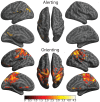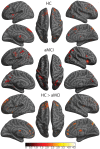Functional neural correlates of attentional deficits in amnestic mild cognitive impairment
- PMID: 23326568
- PMCID: PMC3543395
- DOI: 10.1371/journal.pone.0054035
Functional neural correlates of attentional deficits in amnestic mild cognitive impairment
Abstract
Although amnestic mild cognitive impairment (aMCI; often considered a prodromal phase of Alzheimer's disease, AD) is most recognized by its implications for decline in memory function, research suggests that deficits in attention are present early in aMCI and may be predictive of progression to AD. The present study used functional magnetic resonance imaging to examine differences in the brain during the attention network test between 8 individuals with aMCI and 8 neurologically healthy, demographically matched controls. While there were no significant behavioral differences between groups for the alerting and orienting functions, patients with aMCI showed more activity in neural regions typically associated with the networks subserving these functions (e.g., temporoparietal junction and posterior parietal regions, respectively). More importantly, there were both behavioral (i.e., greater conflict effect) and corresponding neural deficits in executive control (e.g., less activation in the prefrontal and anterior cingulate cortices). Although based on a small number of patients, our findings suggest that deficits of attention, especially the executive control of attention, may significantly contribute to the behavioral and cognitive deficits of aMCI.
Conflict of interest statement
Figures




Similar articles
-
Functional degeneration in dorsal and ventral attention systems in amnestic mild cognitive impairment and Alzheimer's disease: an fMRI study.Neurosci Lett. 2015 Jan 12;585:160-5. doi: 10.1016/j.neulet.2014.11.050. Epub 2014 Dec 3. Neurosci Lett. 2015. PMID: 25481763
-
Cerebrovascular disease influences functional and structural network connectivity in patients with amnestic mild cognitive impairment and Alzheimer's disease.Alzheimers Res Ther. 2018 Aug 18;10(1):82. doi: 10.1186/s13195-018-0413-8. Alzheimers Res Ther. 2018. PMID: 30121086 Free PMC article.
-
Resting state functional connectivity abnormalities and delayed recall performance in patients with amnestic mild cognitive impairment.Brain Imaging Behav. 2020 Feb;14(1):267-277. doi: 10.1007/s11682-018-9974-1. Brain Imaging Behav. 2020. PMID: 30421086
-
Can multi-modal neuroimaging evidence from hippocampus provide biomarkers for the progression of amnestic mild cognitive impairment?Neurosci Bull. 2015 Feb;31(1):128-40. doi: 10.1007/s12264-014-1490-8. Epub 2015 Jan 16. Neurosci Bull. 2015. PMID: 25595368 Free PMC article. Review.
-
Multimodal magnetic resonance imaging on brain network in amnestic mild cognitive impairment: A mini-review.Medicine (Baltimore). 2023 Aug 25;102(34):e34994. doi: 10.1097/MD.0000000000034994. Medicine (Baltimore). 2023. PMID: 37653770 Free PMC article. Review.
Cited by
-
Dysfunctional interactions between the default mode network and the dorsal attention network in subtypes of amnestic mild cognitive impairment.Aging (Albany NY). 2019 Oct 24;11(20):9147-9166. doi: 10.18632/aging.102380. Epub 2019 Oct 24. Aging (Albany NY). 2019. PMID: 31645482 Free PMC article.
-
Toward systems neuroscience in mild cognitive impairment and Alzheimer's disease: a meta-analysis of 75 fMRI studies.Hum Brain Mapp. 2015 Mar;36(3):1217-32. doi: 10.1002/hbm.22689. Epub 2014 Nov 19. Hum Brain Mapp. 2015. PMID: 25411150 Free PMC article. Review.
-
Dissociating Normal Aging from Alzheimer's Disease: A View from Cognitive Neuroscience.J Alzheimers Dis. 2017;57(2):331-352. doi: 10.3233/JAD-161099. J Alzheimers Dis. 2017. PMID: 28269778 Free PMC article. Review.
-
Neural correlates of attention-executive dysfunction in lewy body dementia and Alzheimer's disease.Hum Brain Mapp. 2016 Mar;37(3):1254-70. doi: 10.1002/hbm.23100. Epub 2015 Dec 26. Hum Brain Mapp. 2016. PMID: 26705763 Free PMC article.
-
Neurophysiological and other features of working memory in older adults at risk for dementia.Cogn Neurodyn. 2024 Jun;18(3):795-811. doi: 10.1007/s11571-023-09938-y. Epub 2023 Mar 4. Cogn Neurodyn. 2024. PMID: 38826646 Free PMC article.
References
-
- Geslani DM, Tierney MC, Herrmann N, Szalai JP (2005) Mild cognitive impairment: an operational definition and its conversion rate to Alzheimer’s disease. Dementia and Geriatric Cognitive Disorders 19: 383–389. - PubMed
-
- Gauthier S, Reisberg B, Zaudig M, Petersen RC, Ritchie K, et al. (2006) Mild cognitive impairment. The Lancet 367: 1262–1270. - PubMed
-
- Morris JC, Storandt M, Miller JP, McKeel DW, Price JL, et al. (2001) Mild cognitive impairment represents early-stage Alzheimer disease. Arch Neurol 58: 397–405. - PubMed
-
- Brookmeyer R, Johnson E, Ziegler-Graham K, Arrighi HM (2007) Forecasting the global burden of Alzheimer’s disease. Alzheimer’s and Dementia 3: 186–191. - PubMed
Publication types
MeSH terms
Grants and funding
LinkOut - more resources
Full Text Sources
Other Literature Sources
Medical

